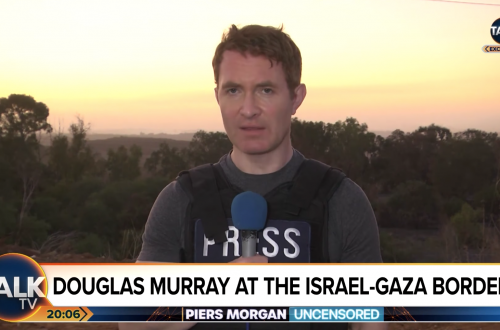Margaret Atwood, who recently resisted calls for a boycott of Israel, has an op ed piece in The Times today (subscription only) and in Haaretz which sketches various possible histories of the years to come. Entitled “Seven futures are possible. Which will it be?”, it surveys various horrific outcomes for the region, while calling for the creation of two states: “Israel” and “Palestine”:
Both are flourishing, and both are members of a regional council that deals with matters affecting the whole area. Trade flows harmoniously between the two, joint development enterprises have been established, know-how is shared, and as in Northern Ireland, peace is paying dividends.
…
Settlers could stay in Palestine if they wished, under lease agreements. The leases and taxes paid by the settlers were a source of income to the Palestinian state, and as their products were no longer boycotted, the settlements did better.
This is very much the sort of future I’d hope for the two nations, although without an enormous amount of optimism. That isn’t the reason that I wanted to blog about this article, however.
The remarkable thing about Atwood’s article is that it is set in a Middle East in which, more or less, only Israelis exist. Certainly, the Palestinians are mentioned, as is Syria and (obliquely) Iran. But, essentially, it is only Israel that is capable of action: all other parties simply react to Israel’s conduct. The argument is, essentially, were Israel to take a few simple steps, the nightmare could be over for everybody.
This is how, in Atwood’s universe, peace breaks out:
First, the Golan Heights was returned to Syria under a pact that created a demilitarized zone with international supervision. The few Israeli inhabitants were allowed to remain if they wished, though they then paid taxes to Syria.
Then, with the help of a now-friendly Syria, Hamas was invited to the peace negotiations. The enlightened leaders – with an eye to Northern Ireland — realized that they couldn’t set as a precondition something that remained to be negotiated, so they didn’t demand the pre-recognition of Israel as a Jewish state. Hamas, to the surprise of many, accepted the invitation, as it had nothing to lose by doing so. Peace was made between Fatah and Hamas, and Palestine was thus able to present a single negotiating team.
Where to start?
Atwood is a novelist, and therefore it would be unfair to expect her to have a close knowledge of Middle Eastern politics. But the notion that Syria is about to become a friend of Israel, merely because the Golan Heights are returned to it, is fantastical. In fairness, Atwood does at least register depersonalised “surprise” that Hamas agrees to participate – and be bound by – negotiations.
In the world painted by Atwood, Syria has no interests of its own, and no foreign policy, except a single easily resolved grievance about the ownership of the Golan Heights. Why Syria should be in alliance with Iran, why it has been seeking to dominate Lebanon since the 1970s, and why it maintains Hezbollah is a complete mystery.
Similarly, the version of Hamas presented here is motivated by a desire for peace, prosperity and statehood. It has “nothing to lose” from peace. When Hamas couped in Gaza, it immediately pursued a policy of eliminating Fatah and suppressing PFLP activists, while launching thousands of missiles at Israel: a policy at odds with those goals.
What of Fatah? Although it has scarcely made the headlines, Abbas has been resisting for months, Obama’s call for face to face talks between Israel and Palestine. It is almost as if Abbas fears the consequences of making peace. Yet, there’s no mention of that in the article either.It is merely Israeli intransigence which has prevented a settlement.
In the real Middle East, Syria – or more properly, the Alawite Baathist regime – has a whole set of regional interests which will not be served by peace with Israel. The last few week’s events in Lebanon illustrate that, very clearly. Similarly, Abbas is dragging his heels because he appreciates that peace with Israel will be painted as a huge betrayal, and may well be his death warrant. As for Hamas – precisely how they transform from an organisation dedicated to bringing on the Final Hour, by killing Jews hiding behind rocks and stones, to the happy partner of Israel in some sort of regional federation, is not made clear. The sad fact is that the closest that Hamas has come to contemplating peace with Israel is the 2004 statement by Abdel Aziz Rantisi that it would settle for a ten year hudna because he had concluded that it was “difficult to liberate all our land at this stage, so we accept a phased liberation”. Perhaps Atwood thinks he was just kidding around, and that they’re motivated by economic rather than spiritual concerns.
Atwood gives almost no thought to Iran, which is odd, given their role as bankrollers and armers of Hezbollah and Hamas, and as a near-nuclear power. Granted, one of Atwood’s seven scenarios ends with “several atomic bombs [which] have cleared the land of human beings”. Why doesn’t Iran scotch this peace agreement, by pulling the strings of its various state and non-state proxies? What does its messianic and theocratic leadership get out of it?
In defence of Margaret Atwood, this article is an expression of earnest hope for a happy future for both Israelis and Palestinians. It is a literary dream, aided by the “smudged… sage [and] sweetgrass” of the aboriginal Americans: not an essay on geopolitics. However, that dream world is populated with Jews and set in a sort of hybrid version of reality: partly modern and partly Biblical.
From the modern world, Atwood gives us comparisons: with Northern Ireland, North Korean, Burma, but particularly South Africa. However, Atwood begins and ends her article with a reference to the Bible: specifically, the book of Daniel:
Picture a minor prophet. Perhaps he’d be working today as an astrologer. He’s looking towards Israel and Palestine, consulting his charts and stars, getting a handle on the future. But the future is never single — there are too many variables – so what he sees is a number of futures.
…
It’s a prophet’s traditional duty to lay out the alternatives – the good futures, and also the bad ones. Prophets – unlike yes-men — tell the powerful not what they want to hear, but what they need to hear. “How can I put this?” thinks the stargazer. “Something beginning with the handwriting on the wall…?”
I haven’t read enough Atwood to know whether she sees the world in terms of Biblical metaphors. There is one quote on her Wikipedia page which suggests that she enjoys playing games with doctrine:
“The animals die that we may live, they are substitute people…And we eat them, out of cans or otherwise; we are eaters of death, dead Christ-flesh resurrecting inside us, granting us life.”
In any case, Atwood’s perspectives are not particularly unusual. Our Western culture is absolutely steeped in the language and imagery of the Old and New Testaments. For two thousand years, these stories formed the bedrock of our world culture. Indeed, it is chiefly atheists, agnostics, and the Biblically-illiterate who fail to recognise the re-iteration of religious themes within secular thought. Religious people naturally view the world through a prism of scripture, of course.
The Old and New Testaments are hugely Judeocentric. In the Old Testament, God enters into a covenant with Jews: accordingly, everything that happens in the world of importance turns on the manner in which Jews observe that Covenant. Likewise, the main theme of the New Testament is the politics of 1st century Jerusalem and Judea, and the relationship between Jesus, his various followers, and a variety of Jewish political groupings (which the New Testament often simply conflates into ‘the Jews’, notwithstanding their doctrinal diversity).
Perhaps this perspective is the key to understanding why Hamas, Syria and Iran are mere cyphers in Atwood’s essay. If you see today’s Middle East as an updating of Bible stories, you’re following a model in which Israel and Jews play centre stage, and other nations and peoples are two dimensional shadows.
Just as light is bent and refracted by a prism, viewing the world through religious fables will not bring us a clear sight of peace.


